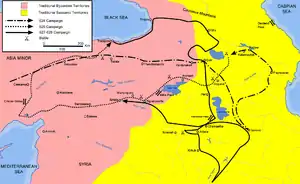625
Year 625 (DCXXV) was a common year starting on Tuesday (link will display the full calendar) of the Julian calendar. The denomination 625 for this year has been used since the early medieval period, when the Anno Domini calendar era became the prevalent method in Europe for naming years.
| Millennium: | 1st millennium |
|---|---|
| Centuries: | |
| Decades: | |
| Years: |
| 625 by topic |
|---|
| Leaders |
| Categories |
|
| Gregorian calendar | 625 DCXXV |
| Ab urbe condita | 1378 |
| Armenian calendar | 74 ԹՎ ՀԴ |
| Assyrian calendar | 5375 |
| Balinese saka calendar | 546–547 |
| Bengali calendar | 32 |
| Berber calendar | 1575 |
| Buddhist calendar | 1169 |
| Burmese calendar | −13 |
| Byzantine calendar | 6133–6134 |
| Chinese calendar | 甲申年 (Wood Monkey) 3321 or 3261 — to — 乙酉年 (Wood Rooster) 3322 or 3262 |
| Coptic calendar | 341–342 |
| Discordian calendar | 1791 |
| Ethiopian calendar | 617–618 |
| Hebrew calendar | 4385–4386 |
| Hindu calendars | |
| - Vikram Samvat | 681–682 |
| - Shaka Samvat | 546–547 |
| - Kali Yuga | 3725–3726 |
| Holocene calendar | 10625 |
| Iranian calendar | 3–4 |
| Islamic calendar | 3–4 |
| Japanese calendar | N/A |
| Javanese calendar | 515–516 |
| Julian calendar | 625 DCXXV |
| Korean calendar | 2958 |
| Minguo calendar | 1287 before ROC 民前1287年 |
| Nanakshahi calendar | −843 |
| Seleucid era | 936/937 AG |
| Thai solar calendar | 1167–1168 |
| Tibetan calendar | 阳木猴年 (male Wood-Monkey) 751 or 370 or −402 — to — 阴木鸡年 (female Wood-Rooster) 752 or 371 or −401 |
Events
Byzantine Empire
- Byzantine–Sassanid War: Emperor Heraclius marches with his forces westward, through the mountains of Corduene. In less than seven days, he bypasses Mount Ararat and captures the strategic fortresses of Amida along the Arsanias River, and Martyropolis on the upper Tigris.[1] The Persian army in northern Mesopotamia withdraws westward across the Euphrates. Heraclius pursues into Cilicia, accompanied by a great train of booty.
- Battle of Sarus: Heraclius is victorious in a Byzantine assault river crossing. The reinforced Persians under Shahrbaraz are defeated along the Sarus River, near Adana (modern Turkey). Heraclius recaptures Cappadocia and Pontus, and returns to Trapezus to spend the winter.[1] Shahrbaraz retreats in good order, and is able to continue his advance through Asia Minor towards Constantinople.
Britain
- King Edwin of Northumbria marries Æthelburga of Kent. As a Christian, she brings her personal chaplain, Paulinus, and encourages her husband to convert to Christianity.
- King Cadfan of Gwynedd dies and is buried at Llangadwaladr, where his memorial stone can still be seen. He is succeeded by his son Cadwallon (approximate date).
- Judicaël becomes high king of Domnonée (northern Brittany).
Asia
- King Pulakeshin II of Chalukya receives Persian envoys, who are sent by King Khosrau II at Badami (southern India).
Religion
- March 19 – Battle of Uhud: Muhammad retreats against the inhabitants of Mecca (Saudi Arabia), which they consider a victory.
- October 25 – Pope Boniface V dies at Rome after a 6-year reign. He is succeeded by Honorius I as the 70th pope.
Births
- Hasan ibn Ali, grandson of Muhammad (d. 670)
- Œthelwald, king of Deira (approximate date)
- Theodo II, duke of Bavaria (approximate date)
- Zhang Jianzhi, official of the Tang Dynasty (d. 706)
Deaths
- October 25 – Pope Boniface V[2]
- Abd-Allah ibn Jahsh, Arab sahabah
- Cadfan ap Iago, king of Gwynedd
References
- Kaegi, Walter Emil (2003), "Heraclius: Emperor of Byzantium", Cambridge University Press, p. 131. ISBN 0-521-81459-6
- "Boniface V | pope". Encyclopedia Britannica. Retrieved January 12, 2021.
This article is issued from Wikipedia. The text is licensed under Creative Commons - Attribution - Sharealike. Additional terms may apply for the media files.
